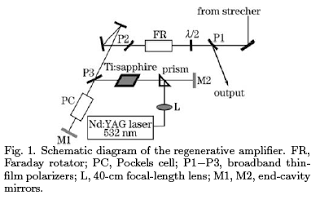100-MHz multi-terawatt femtosecond Ti:sapphire laser with a regenerative amplifier (3 pages 2007)
Chirped pulse amplification (CPA) has become a common technique for damage-free amplification of short optical pulses to terawatt levels and beyond.
Typical high-repetition-rate Ti:sapphire chirped pulse amplification laser systems using electro-optic pulse selection method operate at the range from 10 Hz to 20 kHz with an energy of ∼ mJ, whereas those using acousto-optic pulse selection method can operate at the range from 100 to 250 kHz with an energy of microJoule. The former is limited to approximate 20 kHz mainly by the repetition rate of the pump lasers and the operation repetition rate of Pockels cell. In this letter, a new
electro-optic regenerative amplifier is put forward, which can generate chirped pulses at higher repetition rate.
After the chirped laser pulses are amplified through the laser amplifier chain and recompressed by the grating pair compressor, a femtosecond, multi-terawatt pulse train is obtained. The operating process of the CPA Ti:sapphire laser system is explained as follows. The mode-locked Ti:sapphire oscillator pumped with 5-W power from a Verdi-V5 diode pumped solid state laser (Coherent Inc.) delivers pulses as short as 15 fs at a repetition rate of 80 MHz. The 4-nJ, 15-fs pulses from the oscillator are then stretched to 370 ps. The stretcher design is based on an ¨Offner triplet which has the advantage of aberration free. The stretched pulses are then amplified in three amplifier stages.
The first one is a regenerative amplifier optimized for high-gain production. Figure 1 shows the schematic diagram of our regenerative amplifier. This amplifier uses a 15-mm-thick Ti:sapphire crystal and is pumped with a Nd:YAG laser that is capable of producing 45 mJ of 532-nm radiation at a 10-Hz repetition rate. A Faraday
rotator, thin-film polarizer (P1) and half-wave plate are used to separate the input and amplified pulse train. The Pockels cell, combining with a thin film polarizer (P3), traps one of the injected pulses in the cavity. Following approximately suitable round trips, the cavity-dumping Pockels cell is triggered and a pulse train is rejected from the regenerative amplifier. We change the dumping time and the voltage applied to the electro-optic Q-switch Pockels cell in the regenerative amplifier.We run routinely the 10-TW-class CPA Ti:sapphire laser system, and a 100-MHz femtosecond multi-terawatt laser pulse train including several pulses in per pumping period is obtained. The pulse interval of pulse train can be adjusted by variation of the cavity length of regenerative amplifier.
We have obtained the 100-MHz pulse train with 1-TW peak power per pulse in our 10-TW-class Ti:sapphire laser system. In conclusion, we have demonstrated a new approach to generate a femtosecond multi-terawatt pulse train at repetition rate of 100 MHz in a 10-Hz CPA Ti:sapphire laser system, which contains a regenerative amplifier with an electro-optic Q-switch. The method of producing high power laser pulse train at high repetition rate can be used to any CPA laser systems of single shot or 10-Hz repetition rate. Specially, with the pulse selector as a switch, the CPA Ti:sapphire laser system can produce a femtosecond multi-terawatt pulse train or single pulse at per pumping period. The availability of such laboratory scaled ultrafast terawatt lasers at high repetition rate promises to open the door to investigations into the new fields of physics and applications.
2011 – All-Reflective Ti:Sa Power Amplifier for Petawatt Laser
amplifier delivering 5.77-W average power, 82-MHz repetition rate, 100-fs pulses
A recent laser enabled megawatt class fusion propulsion system was recently proposed.
Ultrafast laser amplifiers are discussed here
In Chapman’s aneutronic fusion reactor scheme, a commercially available benchtop laser starts the reaction. A beam with energy on the order of 2 x 10^18 watts per square centimeter, pulse frequencies up to 75 megahertz, and wavelengths between 1 and 10 micrometers is aimed at a two-layer, 20-centimeter-diameter target.
* The focal intensities of 2 X 10^18 watts per square centimeter is not a problem.
* As shown here the pulse frequency is not a problem
If you liked this article, please give it a quick review on ycombinator or StumbleUpon. Thanks

Brian Wang is a Futurist Thought Leader and a popular Science blogger with 1 million readers per month. His blog Nextbigfuture.com is ranked #1 Science News Blog. It covers many disruptive technology and trends including Space, Robotics, Artificial Intelligence, Medicine, Anti-aging Biotechnology, and Nanotechnology.
Known for identifying cutting edge technologies, he is currently a Co-Founder of a startup and fundraiser for high potential early-stage companies. He is the Head of Research for Allocations for deep technology investments and an Angel Investor at Space Angels.
A frequent speaker at corporations, he has been a TEDx speaker, a Singularity University speaker and guest at numerous interviews for radio and podcasts. He is open to public speaking and advising engagements.


